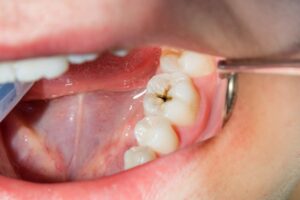
Cavities are one of the most common dental problems, and they don’t always show up in obvious places. While many people can spot one on the surface of a tooth, cavities between the teeth, also known as interproximal cavities, are harder to detect without a dental exam. These hidden holes can do just as much damage if left untreated. So, how can you tell if you have one between your teeth? Here are some signs to watch for and what you should do next.
What Causes Cavities Between Teeth?
Just like other types of cavities, interproximal cavities are caused by plaque buildup. When food particles and bacteria get trapped between teeth, especially if you’re not flossing daily, plaque forms and begins to erode tooth enamel. Over time, this can create decay in the tight spaces your toothbrush can’t reach.
How Are Interproximal Cavities Diagnosed?
The most reliable way to detect a cavity between teeth is through dental X-rays. These images allow your dentist to see inside and between your teeth, revealing any decay that isn’t visible during a visual exam. That’s why regular dental checkups – usually every six months – are so important.
Signs You Might Have a Cavity Between Your Teeth
Tooth Sensitivity
One of the first signs of a cavity between teeth is increased sensitivity, especially when consuming hot, cold, or sweet foods and drinks. If you suddenly notice discomfort in a specific area, it might be due to decay reaching the inner layers of the tooth.
Pain When Chewing
Cavities between teeth can cause localized pain or pressure when you bite down or chew. The pain might feel sharp or dull, depending on the size and location of the cavity.
Bad Breath or a Bad Taste
Persistent bad breath or an unpleasant taste in your mouth, even after brushing, could signal a cavity that’s harboring bacteria between your teeth.
Discoloration or Dark Spots
Although cavities between teeth aren’t always visible, you may notice slight discoloration near the gum line or on the side of a tooth. If you see a shadow or dark spot between your teeth, it’s worth having it checked.
Food Getting Stuck Frequently
If food frequently gets stuck between two specific teeth, it could mean the enamel has eroded and created a space. This can be a sign of an interproximal cavity or gum recession.
Treatment Options
If your dentist detects a cavity between your teeth, treatment will depend on its severity:
- Small cavities may be treated with a dental filling. The decayed area is removed and replaced with a composite material.
- Larger or deeper cavities might require a dental crown or even a root canal if the decay has reached the tooth’s pulp.
- In some cases, preventive steps like fluoride treatments can help reverse early-stage enamel damage before a cavity forms.
Cavities between teeth can be sneaky, developing quietly until they cause discomfort or damage. The best way to catch them early is through good oral hygiene: brushing twice a day, flossing daily, and visiting your dentist regularly. If you’re experiencing sensitivity, pain, or other warning signs, don’t wait. Early detection and treatment can save your tooth and your smile.
About the Practice
If you have a cavity between your teeth, the experts at Fort Dental can take care of it with a composite resin, tooth-colored filling that will blend in with your natural teeth! In addition to fillings, our comprehensive services include everything from preventive care to sedation dentistry to emergency appointments. Whatever your needs are, schedule an appointment through our website or call our Fort Worth office at (817) 292-5957.

